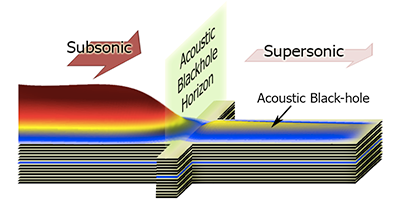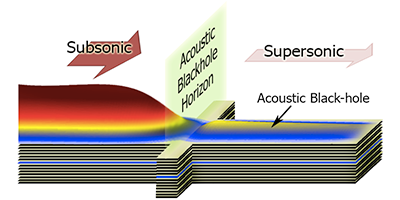A Black Hole for Polaritons
Physicists have in the past created black-hole-like behavior in water waves, cold atoms, and other optical systems. Now a group has produced an analog black hole with polaritons, which are mixed photonic and electronic excitations. The polaritons flow through a one-dimensional semiconductor cavity with an embedded defect that produces an “acoustic horizon,” which traps waves in the quantum fluid similarly to how light waves are trapped at the event horizon of a black hole. Future experiments on this system might reveal a signal that could be the acoustic equivalent to Hawking radiation.
Several theoretical predictions about black holes are nearly impossible to observe from real black holes. In particular, Stephen Hawking predicted thermal radiation from a black hole’s horizon, but the low-temperature (microkelvin) emission from a typical black hole would be swamped by the cosmic microwave background. Researchers have therefore developed a number of acoustic or optical systems that could produce Hawking-like emission—although the exact relation to black hole physics is still debated.
In their experiment, Hai Son Nguyen and colleagues from the Laboratory for Photonics and Nanostructures, France, in collaboration with researchers in Italy, generated a stream of polaritons by exciting with a laser one end of a narrow gallium arsenide microcavity. Halfway down the cavity, the team engineered a defect in the form of a cavity-widening notch. Measurements showed that the polariton flow switched from subsonic to supersonic at the defect, implying the formation of an acoustic horizon. The team estimates the horizon’s Hawking temperature to be at the kelvin scale, which is hotter than other existing black hole analogs. The high temperature could allow for an unequivocal detection of spontaneous Hawking-like emission by observing fluctuations in the polariton density.
–Michael Schirber
This research is published in Physical Review Letters.





